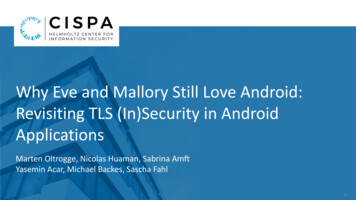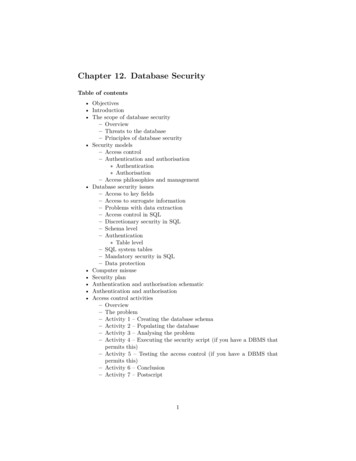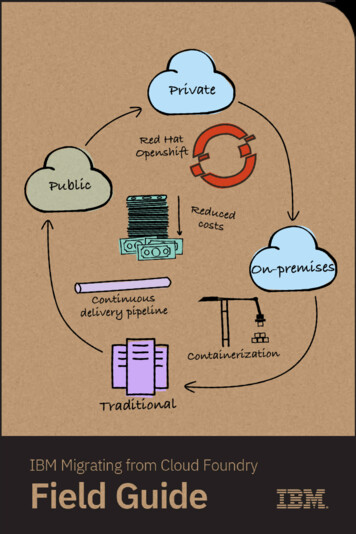
Transcription
Why Eve and Mallory Still Love Android:Revisiting TLS (In)Security in AndroidApplicationsMarten Oltrogge, Nicolas Huaman, Sabrina AmftYasemin Acar, Michael Backes, Sascha Fahl0
Android and TLS - Prior ResearchLong History of research on the urgent stateof custom TLS in Android apps rendering themvulnerable for MITMAs@Overridepublic boolean verify(String host,SSLSession session) {return true;}FAHL et al. Why Eve and Mallory love Android: An analysis of Android SSL (in)security [54]FAHL et al. Rethinking SSL Development in an Appified World [56]GEORGIEV et al. The most dangerous code in the world: validating SSL certificates in non-browser software [58]CHOTHIA et al. Why banker bob (still) can’t get tls right: A security analysis of tls in leading uk banking apps [47]CONTI et al. Mind the hand you shake-protecting mobile devices from SSL usage vulnerabilities [48]OLTROGGE et al. To Pin or Not to Pin - Helping App Developers Bullet Proof Their TLS Connections [74]ONWUZURIKE et al. Danger is my middle name: experimenting with SSL vulnerabilities in Android apps [77]SOUNTHIRARAJ et al. SMV-Hunter: Large scale, automated detection of SSL/TLS man-in-the-middle vulnerabilitiesin android apps [84]@Overridepublic void checkServerTrusted(X509Certificate[] chain, String authType)throws CertificateException {}TENDULKAR et al. An Application Package Configuration Approach to Mitigating Android SSL Vulnerabilities [85]OLTROGGE et al. The rise of the citizen developer: Assessing the security impact of online app generators [75]Some proposed countermeasures[56] and [85] propose a declarative configuration-driven approach letting developers implement custom TLSwithout code@Overridepublic void onReceivedSslError (WebView view,SslErrorHandler handler,SslError error) {handler.proceed();}Why Eve and Mallory Still Love Android: Revisiting TLS (In)Security in Android Applications - USENIX SECURITY ‘211
Android and TLS - New CountermeasuresTo address this urgent state, new countermeasures and novelmechanisms have been introduced: Network Security Configuration (NSC) added in Android 7 tokeep developers from implementing possibly insecure customcertificate validation codeSafe defaults to make mounting of MITMAs harder- Not trust for user CAs by default in Android 7- Enforcing HTTPS by default in Android 9Safeguards to block apps containing vulnerable certificatevalidation code@Overridepublic boolean verify(String host,SSLSession session) {return true;}@Overridepublic void checkServerTrusted(X509Certificate[] chain, String authType)throws CertificateException {}@Overridepublic void onReceivedSslError (WebView view,SslErrorHandler handler,SslError error) {handler.proceed();}Why Eve and Mallory Still Love Android: Revisiting TLS (In)Security in Android Applications - USENIX SECURITY ‘212
Network security configuration - Features Allows to implement custom network security behaviour without writing code-Allow or disallow cleartext traffic ?xml version "1.0" ? network-security-config base-config cleartextTrafficPermitted "[true false]"/ domain-config cleartextTrafficPermitted "[true false]" domain includeSubdomains "true" example.com /domain /domain-config /network-security-config Why Eve and Mallory Still Love Android: Revisiting TLS (In)Security in Android Applications - USENIX SECURITY ‘213
Network security configuration - Features Allows to implement custom network security behaviour without writing code-Allow or disallow cleartext trafficConfigure trust anchors ?xml version "1.0" ? network-security-config domain-config domain includeSubdomains "true" example.com /domain trust-anchors certificates src "system"/ certificates src "user"/ certificates src "@raw/ca"/ /trust-anchors /domain-config /network-security-config Why Eve and Mallory Still Love Android: Revisiting TLS (In)Security in Android Applications - USENIX SECURITY ‘214
Network security configuration - Features Allows to implement custom network security behaviour without writing code-Allow or disallow cleartext trafficConfigure trust anchorsImplement Pinning without any code ?xml version "1.0" ? network-security-config domain-config domain includeSubdomains "true" example.com /domain pin-set expiration "." pin digest "SHA-256" 7HIpactkIAq2Y49orFOOQKurWxmmSFZhBCoQYcRhJ3Y /pin pin digest "SHA-256" fwza0LRMXouZHRC8Ei 4PyuldPDcf3UKgO/04cDM1oE /pin /pin-set /domain-config /network-security-config Why Eve and Mallory Still Love Android: Revisiting TLS (In)Security in Android Applications - USENIX SECURITY ‘215
Network security configuration - Security Analysis Collected 1,335,322 Apps (between 2016/08/22 and 2020/03/18)Detected NSC in 99,212 AppsCould analyze 96,400 custom NSC files Adoption correlates with enforcement of Android 9 which deactivates cleartext traffic by defaultWhy Eve and Mallory Still Love Android: Revisiting TLS (In)Security in Android Applications - USENIX SECURITY ‘216
Network security configuration - Security Analysis Cleartext traffic configuration- Allowing cleartext traffic again is most prominent use case of NSC ( 98%)- Undermine safe defaults (introduced in Android 9)-In-depth analysis of affected domains Cleartext traffic allowed for 24,653 domains 8,935 of these domains support HTTPS cleartext traffic not necessaryWe find especially third party libraries to instruct developers to allow cleartext traffic Local caching & Ad-LibrariesWhy Eve and Mallory Still Love Android: Revisiting TLS (In)Security in Android Applications - USENIX SECURITY ‘217
Network security configuration - Security Analysis Custom Trust Anchors configuration- 8,606 Apps re-enable trust for user CAs (8.67%)- Undermine safe defaults (introduced with Android 7)-Gathered data on distribution of Trust Anchor configurationsIn-depth analysis of Custom Trusted CAs 759 (partially) only trust their own set of CAs (30 globally, 744 for domains) 836 apps added supplementary certificates (784 globally, 58 for domains)Find Mis-Use of debug configuration At least for 41 cases, we find “Proxy” Certificates registered outside debug-overrides trust-anchors certificates src "system"/ certificates src "user"/ certificates src "@raw/ca"/ /trust-anchors Why Eve and Mallory Still Love Android: Revisiting TLS (In)Security in Android Applications - USENIX SECURITY ‘218
Network security configuration - Security Analysis Pinning configuration- Only 663 Apps (0.67%) make use pinning- Limited use of NSC for security enhancements-Conducted an in-depth Pin Analysis for domains in pinning configurations Fetched certificates for domains to match against pinsAnalysis of backup pinsAnalysis of pins’ expiration domain-config domain includeSubdomains "true" example.com /domain pin-set expiration "." pin digest "SHA-256" 7HIpactkIAq2Y49orFOOQKurWxmmSFZhBCoQYcRhJ3Y /pin pin digest "SHA-256" fwza0LRMXouZHRC8Ei 4PyuldPDcf3UKgO/04cDM1oE /pin /pin-set /domain-config Why Eve and Mallory Still Love Android: Revisiting TLS (In)Security in Android Applications - USENIX SECURITY ‘219
Network security configuration - Security Analysis Malformed NSC configurations- Flawed parameter values for domain domain-config has no effect e.g. using URLs (e.g. https://.) instead of domains- Ambiguous Pinning configurations Pinning has no effect 6 Apps with trust anchors with oververridePins ”true” Apps that allow cleartext traffic for pinned domains Obviously non-functional pinsRoot causes: C/P, limited documentation and tool support domain-config domain cleartextTrafficPermitted "true" https://example.com /domain pin-set expiration "." pin digest "SHA-256" BBBBBBBBBBBBBBBBBBBB.BBBBBBBBBBBBBBBBBB /pin /pin-set trust-anchors certificates src "system" overridePins ”true”/ /trust-anchors /domain-config Why Eve and Mallory Still Love Android: Revisiting TLS (In)Security in Android Applications - USENIX SECURITY ‘2110
Efficacy of Google Play Safeguards Evaluating the efficacy of Google Play Safeguards:- Built various insecure custom TLS samples- Published on Play@Overridepublic boolean verify(String host,SSLSession session) {return true;}@Overridepublic void checkServerTrusted(X509Certificate[] chain, String authType)throws CertificateException {}@Overridepublic void onReceivedSslError (WebView view,SslErrorHandler handler,SslError error) {handler.proceed();}Why Eve and Mallory Still Love Android: Revisiting TLS (In)Security in Android Applications - USENIX SECURITY ‘2111
Efficacy of Google Play Safeguards Evaluating the efficacy of Google Play Safeguards:- Built various insecure custom TLS samples- Published on Play- Violating policies@Overridepublic boolean verify(String host,SSLSession session) {return true;}@Overridepublic void checkServerTrusted(X509Certificate[] chain, String authType)throws CertificateException {}@Overridepublic void onReceivedSslError (WebView view,SslErrorHandler handler,SslError error) {handler.proceed();}Why Eve and Mallory Still Love Android: Revisiting TLS (In)Security in Android Applications - USENIX SECURITY ‘2112
Efficacy of Google Play Safeguards Evaluating the efficacy of Google Play Safeguards:- Built various insecure custom TLS samples- Published on Play- Violating policies Result- Only in two cases app was rejected WebViewClient only calling proceed() onTLS error Insecure version of Acra library likelyfingerprinted as parts are not blocked- Limited capabilities for detecting dangerousimplementations- Only trivial cases catchedWhy Eve and Mallory Still Love Android: Revisiting TLS (In)Security in Android Applications - USENIX SECURITY ‘2113
Security impact of our findings Assessing impact of NSC settings- NSC impacts security on all levels of popularity- Manual analysis of apps allowing HTTP threats for eavesdropping sensitive data transmitted via HTTP including Login Data Assessing prevalence of insecure TLS code in Apps:- Replicated Fahl et al. [54]- Used CryptoGuard for 15,000 recent Apps- Checked for insecure HostnameVerifier andTrustManager implementations- Result Still find insecure TLS code in 5,511 Apps Results in line with prior workWhy Eve and Mallory Still Love Android: Revisiting TLS (In)Security in Android Applications - USENIX SECURITY ‘2114
Discussion and TakeawaysCustomization is still Harmful: New safe defaults enhanced security- HTTPS and no trust for user CAs by default- Reduce attack surface for MITMAsNSC mostly used to undermine safe defaults ( 88%)Sparse use to actually enhancing security as only663 use pinningSafeguards are insufficient: New policies to avoid common pitfalls of insecurecertificate validation implementationsEnforcement still insufficientInsecure implementation still present in the wildCustomization is Error-Prone: New forms of misconfiguration & misconceptionEven if intended to enhance security- Can cause the opposite- If tools are not used correctlyUndiscerning use of C/P code samplesLimited (tool) support (e.g. LINT)Recommendation: Need for better (tool) support and documentationEnhanced capabilities of SafeguardsWhy Eve and Mallory Still Love Android: Revisiting TLS (In)Security in Android Applications - USENIX SECURITY ‘2115
Thank youQuestions?Why Eve and Mallory Still Love Android: Revisiting TLS (In)Security in Android Applications - USENIX SECURITY ‘2116
Why Eve and Mallory Still Love Android: Revisiting TLS (In)Security in Android Applications - USENIX SECURITY ‘2119
Why Eve and Mallory Still Love Android: Revisiting TLS (In)Security in Android Applications - USENIX SECURITY '21 To address this urgent state, new countermeasures and novel mechanisms have been introduced: Network Security Configuration (NSC) added in Android 7 to keep developers from implementing possibly insecure custom










